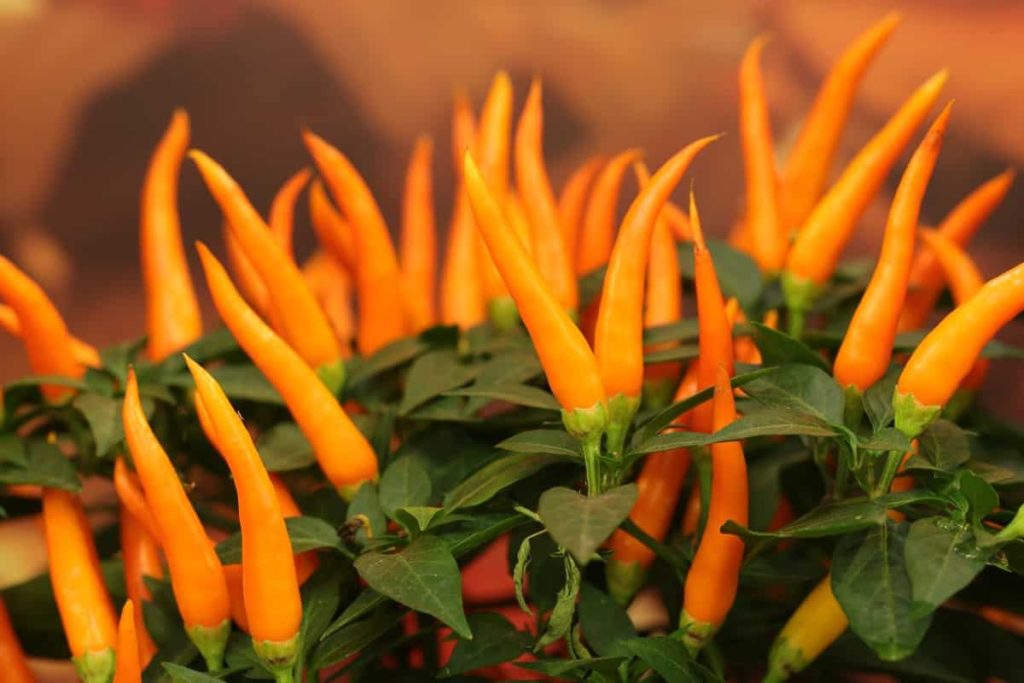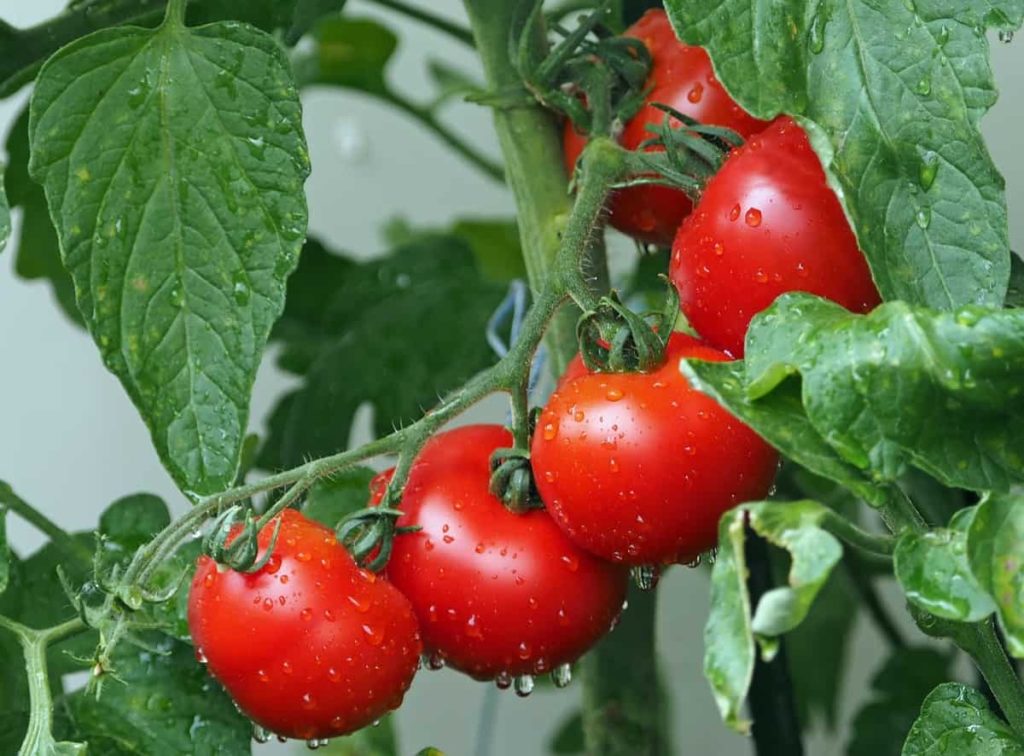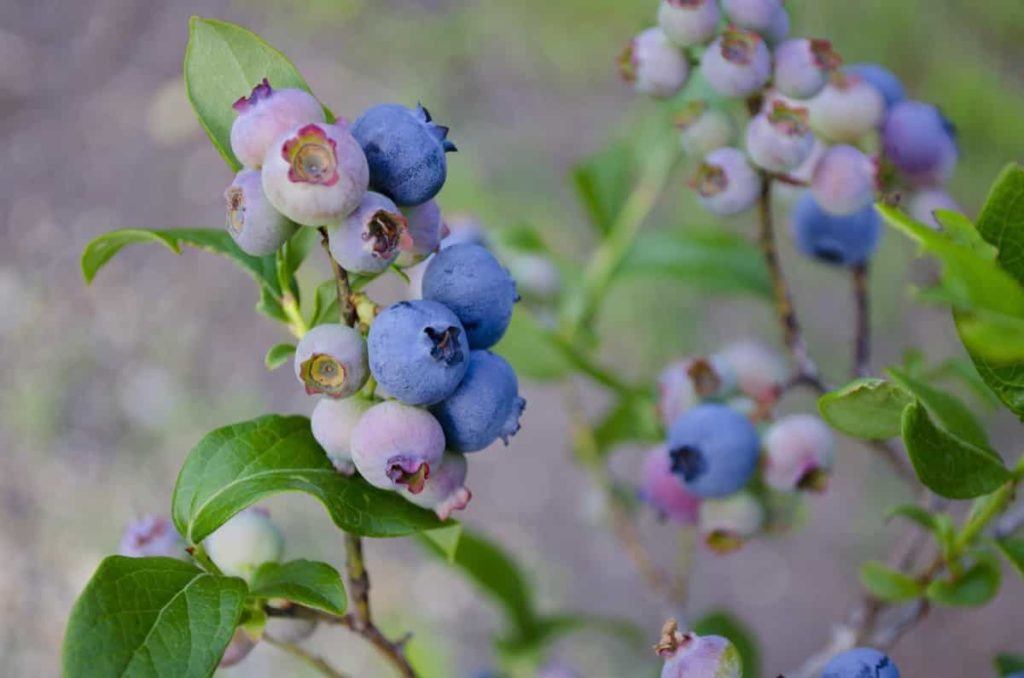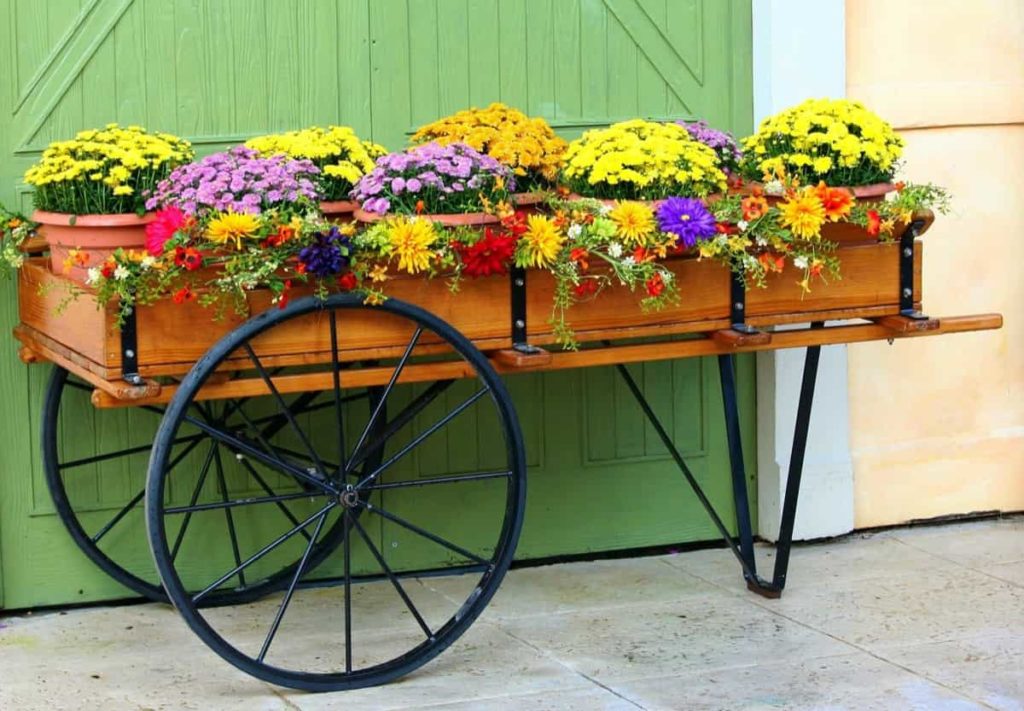If you don’t have the space for a garden in your backyard or the area you have accessible isn’t large enough, you may want to think about planting your plants in pots so that they are healthy and full of nutrients instead. It is possible to have a thriving container garden on a window sill, patio, balcony, or even a front porch if there is enough room.

Changing to container gardening is one way to circumvent challenges like diseases transmitted via the soil, worms, and insufficient soil quality. Plant breeders and seed companies are now developing plants that are mainly intended to grow well in containers in response to the growing popularity of container gardening. Growing plants in containers offer a unique opportunity for creative landscaping.
Adding barrels filled with cherry tomatoes or a colorful herb mixture can enliven an uninspiring patio space. On an apartment balcony, a cool and shaded spot can be produced using planter boxes and trellises in addition to one another. Growing plants in containers open the door to various creative possibilities.
Below we tell you about Colorado container gardening, balcony plants for Colorado in containers, best container plants for Colorado, and best flowers for pots in Colorado, and a step-by-step procedure to grow various plants, such as fruits, vegetables, herbs, and flowers, in containers in Colorado.
Container gardening has been more popular throughout Colorado, with several communities, including Denver, Aurora, Lakewood, and Fort Collins, serving as regional epicenters for the trend. We believe this information will assist the people of Colorado in promoting and establishing container gardens for various plants.
What are the planting zones/ USDA hardiness zones of Colorado?
Despite its reputation as a winter wonderland, Colorado has much more to offer than simply its snow-covered mountains and world-class skiing. Colorado’s planting zones are equally as diverse as the state’s climate, which is tremendously variable. Most of the state is semi-arid except for the eastern area, where it may be anything from semi-arid to alpine, with a wide variety of microclimates ranging from subtropical to humid subtropical, humid continental, Mediterranean, and even subarctic.
Even though they often have record snowfall, the state is known for its temperate temperatures and sunny days, contributing to a fantastic planting season. When designing a garden in Colorado, it is critical first to select the plant and the planting zone to be located. With the help of an interactive planting zone map, it is simple to identify a zone, making it easier to choose plants that are well-suited to the local environment.
Knowing which plants and vegetables grow best in zones 3a to 7a in Colorado before starting a garden might help alleviate some of the worry and frustration that comes with a failing garden. Because they are more likely to stock just those successful plant kinds in a particular region, local nurseries are an excellent location to begin one’s search. If you do not know what plants to grow, you should inquire about direction or assistance at the nursery.
Even though Colorado has a growing season on the shorter end of the spectrum, it is possible to grow a wide variety of fruits, vegetables, and flowers in the state’s several growth zones. Of course, it would help if you planted cherry tomatoes, lettuce, Swiss chard, and other herbs in a vegetable garden. Begonias, primrose, blue salvia, hosta lilies, and blue moon wisteria are just a few of the flowers and plants that have a good chance of flourishing in this environment.
Colorado container gardening: Step by step guide to start container gardening
Select the right container
Several materials, including clay, wood, plastic, and metal, can be used for containers. Soil should not pour out of a container and should be appropriate drainage. Containers should also never have housed any materials that might be dangerous to plants or humans. In addition to the barrels, cut-off milk and bleach bottles and window boxes, plastic-lined laundry baskets, and even sections of drainage pipe and cement blocks, there are many more options.
Redwood and cedar are the most rot-resistant timbers to make a planting box. However, cedars are much more common than redwoods. Wood lattice coated with black plastic, then filled with a lightweight medium, or welded wire cylinders, sphagnum moss-lined, then filled with soil mix, are two examples of vertical planters made by certain gardeners. Your vertical planter may need the use of 2-inch diameter perforated plastic tubing for watering purposes.
If you use a container, ensure the bottom has drainage holes so the roots don’t sit in water. At least six to eight inches deep is required for root development in most plants. The container can be utilized if it satisfies the fundamental specifications outlined above. The creative reuse makes container gardening much more fun for abandoned things and the creation of eye-catching patio planters.
Dolly or platforms with wheels or casters might be used to transport the containers easily. Plants can be easily moved about an apartment or balcony to make the most of the available light and space and prevent being destroyed by extremely bad weather.
Choose the right potting mix
To grow plants in containers successfully, you will need a potting mix that is just moderately dense. It is often impossible to utilize soil directly from a garden in a container since the soil can include excessive clay. The particles that makeup clay soil are so minute that they can only be seen using a microscope. The negative characteristics of clay are enhanced when it is contained in a container.
When wet, it retains an excessive amount of moisture, which results in an inadequate supply of oxygen to the roots; when dry, it pulls away from the edges of the container. Because plant roots need air and water, the media used in containers must be porous to sustain plant life. If it is of sufficient quality, pre-packaged potting soil, which can be found at most local garden stores, is not only relatively light in weight but also has the potential to form an excellent container media.
In most cases, soilless mixes such as perlite mix and similar products are insufficient for container plant growing since they do not provide sufficient support to the plant roots. When combined with a lightweight container, severe winds have the potential to topple plants, causing extensive harm to the plant’s environment. Also, soilless mixtures are sterile and don’t have many nutrients, so when fertilizers are added, they also need to include trace elements.
If you want to use a sterile mix, you can add garden soil to make it heavier and improve its ability to retain water, but you should be aware that this can also bring in pests, weeds, and illnesses. Purchasing pre-packaged or soilless mixtures for a big container garden may be extremely expensive.
You can try making your own by combining one part peat moss, one part garden loam, one part clean, coarse (builder’s) sand or perlite, and an appropriate amount of slow-release fertilizer (14-14-14), proportioned according to the size of the the the container. Lime could also be required to get the pH up to around 6.5. In any case, doing a soil test is beneficial for estimating the nutrient and pH requirements, just as in a big garden.
Start planting your container garden
Planting time for crops to be grown in containers is the same as planting time for crops to be grown in a traditional garden. Put the soil mixture with a little moisture into a clean container until it is within 1 to 2 inches of the top. If you soak the peat moss before placing the mixture into the container, it will be able to absorb water and combine with the other ingredients more efficiently. The directions on the packaging should be followed precisely when sowing the seeds or planting the transplants.
On or inside each container, affix a label stating the plant’s name, variety, and the date it was planted. After planting the seeds, you should carefully moisten the soil while being cautious not to wash away or disturb the seeds. When seedlings have 2 or 3 leaves, thin them. To prevent harm to the plants’ roots at a later time, cages, stakes, or other types of supports should be put in place while the plants are still very young.
Water your container plants
Ensure to provide the plants that are kept in containers with a lot of water. Containers are susceptible to rapid soil dehydration due to their relatively low amount of soil, making them particularly unsuitable for placement on concrete patios in direct sunlight. It’s possible that a once-daily or even twice-daily watering is required. Use water up to the point where it seeps out of the drainage holes.
If you live on an upper-level balcony, this might cause issues with your neighbors. Therefore, you should plan for the drainage of water. It works well to have large trays loaded with coarse marble chips. If the pot touches the drainage water, it will soak up all the water and make it overly moist. It is essential that the ground never gets waterlogged or have water pooling on top of it. Container plants that are kept at a humidity level that is too high are more likely to suffer from root rots when the temperature is chilly.
Clay pots and other porous containers provide increased evaporation from the edges of the pots. Therefore, watering must be done more often with these types of containers. Additionally, smaller pots tend to dry up faster than bigger ones. As soon as the soil looks to be drying up, gather the pots together to form a canopy of greenery that shields the soil from the sun and keeps it cooler. If you have a heated patio, you should probably think about mounting pots on pallets or other things that will enable airflow underneath the containers and prevent them from coming into direct touch with the cement.
Containers should be checked at a minimum once per day and preferably twice on hot, dry, or windy days. Try sticking your finger into the ground to see how wet it is. Mulching and windbreaks are two techniques that may assist cut down on the amount of water needed for containers. Consider installing an autonomous drip emitter watering system if you are often absent from your property.
Start fertilizing your container garden
Your plants will have access to sufficient nutrients for 8 to 10 weeks if you utilize a soil mixture that also contains fertilizer. If the plants are grown for longer, the required amount of a water-soluble fertilizer should be used. It must be performed every 2 to 3 weeks. Fish emulsion or compost can be added to the soil to enrich it with trace elements.
Do not apply more fertilizer than the amount advised, as this might lead to fertilizer burn. Because container plants lack huge amounts of soil and humus, they are more susceptible to over-fertilization and over-liming. Therefore, even if a small amount may benefit the plants, this does not necessarily imply that a large amount will be even more beneficial.
Pest management and general care for your container garden
Many kinds of pests and diseases can affect container gardens in general and can also affect plants grown in containers. Do frequent checks on plants to see whether or not they are infected with diseases and whether or not they have insects that feed on the foliage or the fruit.
Take precautions to protect plants from the very high heat from the sun reflecting off the pavement. During the warmest portion of the day, either relocate them to a cooler area or provide some shade for them. Plants should be relocated to a protected place during strong wind, rain, or hail storms, as well as to protect from early autumn frosts.
Top vegetables to grow in containers in Colorado
Brussels sprouts, Cabbage, English Peas, Kale, Lettuce, Radish, Spinach, and Turnips are some of the plants that do well when planted in gardens throughout the autumn, spring, and early spring in containers in Colorado.
Lettuce: One of the simplest crops to produce in Colorado is lettuce, which is also cold resilient, allowing it to thrive even in the presence of snow or frost. Once a week is all you require to maintain this plant. All-year-round harvesting means no fertilizer is needed.
Cucumbers: Cucumbers are perfect for container gardeners in Colorado since they are incredibly resistant and can tolerate both hot and cold climates to provide a yield throughout the year. Cross-pollinating plants, such as those found in carrots, beans, and tomatoes, will provide an even greater crop if grown near one other.
Kale: Cold conditions are no match for this tough veggie. A harsh winter will cause it to crumble, while a mild one will allow it to flourish all year. One of the few decorative vegetables that can be grown in your garden, it has a beautiful look.
Peppers: A summer garden in Colorado would be incomplete without peppers, which thrive in the state’s hot climate. Your plants’ growth and food production improve with increasing temperature. It’s another perk of peppers to grow in your garden that insects aren’t fond of.
Tomatoes: Several varieties of tomatoes thrive in Colorado, particularly during the hot summer months. They are easy to care for and ideal for vertical planting. They thrive on poor soil and can be grown in containers.
In case you missed it: Alaska Container Gardening: Guide for How to Grow Fruits, Vegetables, Flowers, and Herbs at Home for Beginners

Top fruits to grow in containers in Colorado
In Colorado, it is possible to grow almost any deciduous fruit tree in a container, including apples, sweet and tart cherries, pears, apricots, peaches, nectarines, plums, etc.
Strawberries: For pots, strawberries are the ideal choice. They need a lot of sunlight. It’s important to ensure that the crown is even with the compost surface.
Raspberries: Raspberry plants may be grown in pots, allowing you to enjoy the fruits of your labor for a long time. The less bushy summer fruiting cultivars are better if you’re short on space. Provide a secluded area that is both sunny and well-ventilated.
Apples: Even a modest balcony or patio may be transformed into an apple orchard thanks to dwarf apple plants. When working with limited room, picking a self-fertile apple tree is advisable.
Cherries: Several bush cherry varieties may be grown in containers. Cherries do not like to have wet feet. Thus, they prefer a temperate temperature with just a little water. Cherry trees want soils rich in organic matter and well-drained.
Blueberries: If you don’t have a garden or your soil isn’t acidic, you should consider growing blueberries in containers. You must provide potting mix and a big container for your blueberry plant if you want it to develop easily and happily produce fruit for many years.
In case you missed it: Arizona Container Gardening: Guide for How to Start with Vegetables, Fruits, Flowers, and Herbs at Home for Beginners

Top herbs to grow in containers in Colorado
To flavor, your house, start basil, parsley, mint, and cilantro inside. Perennial herbs thrive in Colorado Springs, including lavender, chives, rosemary, and oregano.
Rosemary: Rosemary grows to its maximum potential in sunny locations with soil that drains properly. Ensure the roots of this plant don’t become wet and prevent overwatering. Rosemary thrives in settings that are hot, dry, and sunny.
In case you missed it: Alabama Container Gardening: Guide for How To Start with Vegetables, Fruits, Herbs, and Flowers for beginners

Parsley: Slow to start, producing an abundance of new leaves when it does. One of the few plants that may benefit from some fertilizer, it requires more water than most herbs. So every year, in the early spring, give the soil a gentle feeding with a slow-release organic fertilizer.
Sage: Sage plants need full sun and well-draining soil to thrive. Sage can’t thrive if its roots are consistently damp.
Cilantro: As one of the few plants that benefit from some shade to slow its blooming rate, cilantro can also thrive in direct sunshine. In addition to keeping cilantro hydrated and nourished, this will help avoid early bolting.
In case you missed it: New York Container Gardening: Guide for Vegetables, Herbs, Flowers, and Fruits at Home

Mint: As with other herbs, this resilient one does not need direct sunshine to thrive. Organic matter-rich soil is all that mint requires to grow. Take frequent breaks from watering to pinch off fresh mint leaves.
Top flowers to grow in containers in Colorado
In Colorado, it is possible to grow various flowers in containers, like geraniums, petunias, marigolds, zinnias, calibrachoa, inpatients, snapdragons, begonia, and other flowers. We have listed some of them below:
In case you missed it: Tennessee Container Gardening: Guide for Vegetables, Fruits, Flowers, and Herbs at Home

Petunias: For their hardiness and ease of maintenance, petunias have long been a popular choice for container gardening. These plants should be placed in full sunlight, although they may also withstand partial shade. They bloom all summer long on long stalks, making them ideal for hanging baskets and window boxes!
Geraniums: Their adaptability makes them an excellent option for container gardening. Geraniums are great for window boxes and hanging baskets because of their tall flower stalks and stunning blooms.
Zinnias: Because of their hardiness and ease of maintenance, zinnias are another favorite container flower. Although they prefer full sun, these plants can thrive in partial shade. Hanging baskets and window boxes will benefit significantly from their lengthy flowering season and thick flower stalks.
Marigolds: With their hardiness and ease of maintenance, marigolds are an excellent option for container gardening. This plant thrives best in full light, although it can also handle moderate shade. You may use them in hanging baskets or window boxes because their long stems produce gorgeous summer blooms!
Calibrachoa: An adaptable and colorful option for container gardening, calibrachoa is another excellent option. Although they prefer full sun, these plants may also thrive in partial shade. In addition, you can use them in hanging baskets or window boxes because their long stems produce gorgeous summer blooms!
- Gardening Techniques in Planting Vegetables
- Where to Place Indoor Plants in Your Home
- How to Grow Tomatoes Organically at Home: A Comprehensive Guide
- Organic Gardening on a Budget: Low-Cost Methods and Materials
- Gongura Seed Germination and Planting Methods
- Cabbage Seed Germination and Selection
- Broccoli Seed Germination and Selection
- Asparagus Seed Germination and Variety Selection
- Seasonal Flower Gardening: Best Practices for Spring, Summer, Fall, and Winter
- How to Grow Hibiscus from Flower
- Plantation Ideas for Home Decoration: A Beginners Guide
- Flower Garden Designs and Layouts for Beginners
- Planting and Spacing Techniques in Papaya: A Beginner’s Guide
- Growing Gold: Essential Techniques for Planting Pineapples
- How to Make Kalanchoe Plant Bushy: Home Remedies and Solutions
- 11 Reasons Why Your Gardenia is Not Blooming: Home Remedies and Solutions
- Eco Elegance: The Guide to Designing a Drought-Tolerant Landscape
- Gardening on a Slope: Strategies for Hillside Landscaping
- Nourish and Flourish: Top Organic Mulches for Thriving House Plants
- Everything You Want to Know about Indian Mogra Flower: Discover Uses and Growing
- Green Thumb Success: Expert Tips for Cultivating Greenhouse Pumpkins All Year Round
- Maximize Growth & Flavor: The Ultimate Guide to Companion Planting in Herb Gardens
- How to Control Rhododendron Problems Naturally: Home Remedies and Organic Ways to Fix Them
- Natural Magic: The Remarkable Benefits of Cinnamon for Plants
- Best Steps to Revive Dying Tulip with Natural and Organic Treatment
- 10 Reasons Why Your Angel Trumpet is Not Blooming: Remedies and Treatment
- How to Fix Periwinkle Leaf and Flower-Related Problems: Natural Remedies and Solutions
- How to Fix Zinnias Leaf and Flower Problems: Discover Natural and Home Remedies
- Organic Steps to Induce Lemon Tree Flowers: A Comprehensive Guide
- Bloom Booster: Crafting the Perfect Homemade Bougainvillea Fertilizer
- Optimizing Growth: A Guide to Applying NPK Fertilizer for Potted Plants
- 10 Best Homemade Fertilizers for Rubber Plant: DIY Recipes and Application Method
- How to Boost Female Pumpkin Flowers: Effective Steps for More Flowers and High Yields
- Transform Your Indoor Garden: Top Benefits of Pink Salt for Houseplants
- 10 Best Homemade Fertilizers for Peacock Plants (Calathea): Easy DIY Guide
- Unlock Blooms: 9 Reasons Why Your Potted Chrysanthemum is Not Blooming